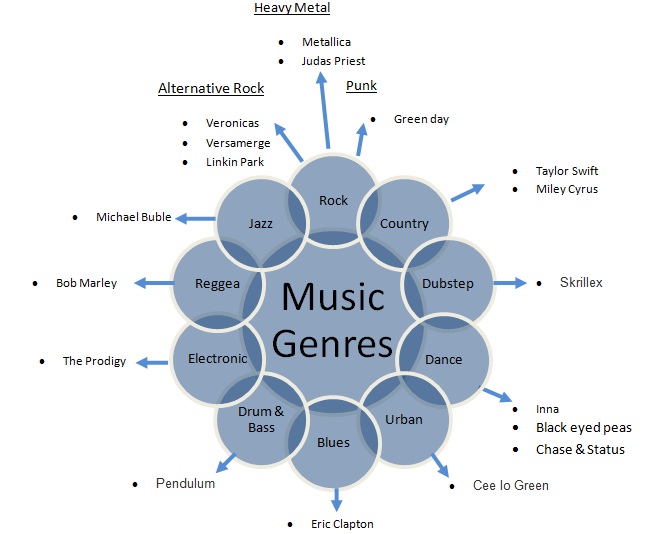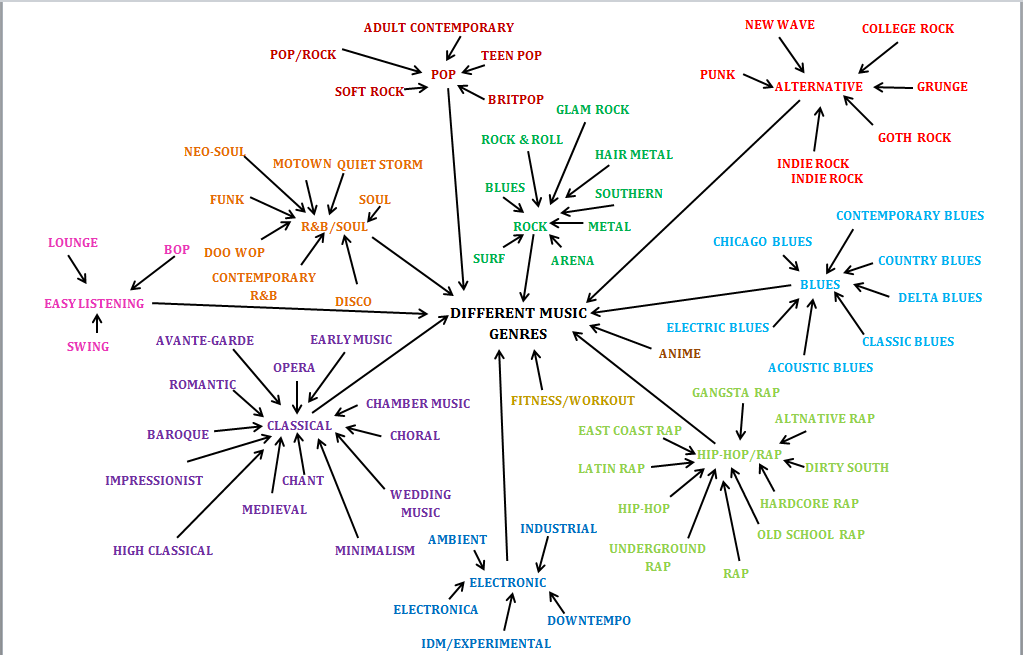

The style quickly spread throughout the country, with larger bands adding piano, trumpet and saxophone. Singers were men or women with big voices, and audiences loved it. The early forms of R&B were loud and lively and mostly played on drums, double bass, and electric guitar. Photo right: Louis Jordan’s Tympany Five in New York, mid-1940’s ( William P. Most young people who went to these places thought blues was old-fashioned, so the bands had to develop a new style, and what they created was "rhythm and blues" (or R&B*). But to get work, they had to attract audiences. They formed small bands and looked for work in cheap bars and clubs.
MUSIC GENRES DEFINED PROFESSIONAL
Many African Americans were professional blues musicians, but making money wasn't easy.

The best of these musicians included Charlie Parker, Thelonious Monk, John Coltrane, Miles Davis and Charles Mingus.Īs jazz was becoming more and more popular in the 1930s and 1940 s, another new genre was starting to develop. These new styles weren't as easy to dance to as swing, so they weren't as popular, but they found a new audience of serious listeners for whom modern jazz was art music rather than popular music. Before long they were playing exciting new styles like bebop and modal jazz. They wanted the freedom to improvise and began experimenting in their own bands. All the most popular singers of the day, like Bing Crosby, Frank Sinatra and Nat King Cole, sang with jazz orchestras.īut by the 1950s many young musicians no longer wanted to play in jazz orchestras. Some of the greatest jazz orchestras were those led by Duke Ellington, Count Basie and Fletcher Henderson, with whom Louis Armstrong played. Swing was hugely popular in the 1940 s, becoming the music that nearly everyone danced to. These new styles were played by jazz orchestras with a rhythm section (drums, double bass, piano and guitar), brass and woodwind sections, and sometimes strings and one or more singers. Then he was in New York City in the 1930s when big band jazz and swing were developing. In the 1920s he was in Chicago inventing new ways of improvising with Joe "King" Oliver and his band. He was in New Orleans, his home town, in the 1910s when the marching-band style of New Orleans jazz (or "dixieland") was being born. One of jazz's greatest musicians was the trumpet player Louis Armstrong, who helped to develop many styles of jazz. Some even mixed European harmony with the rhythms and scales of blues, and it was from this mixture that "jazz" was born. Most African American musicians only played blues, but some played classical music as well and learned European harmony. For later blues, try Billie Holiday, Muddy Waters, Howlin' Wolf and John Lee Hooker. If you'd like to hear some early blues, try searching for the recordings of Blind Willie McTell, Bukka White and Lightnin' Hopkins. But wherever the music was played, listeners heard a sound that was going to influence nearly every genre of popular music to come, from jazz and soul to hip hop. Various blues styles developed over the years, some in small towns of the American south and others in cities like Chicago and New Orleans. But others were about being in love, or having fun, and these were up-tempo and good to dance to. Some blues songs told stories of heartbreak and pain, and these were often slow and sad. It was this new combination of African and Western music that led to the genre we now call "blues". And when they expressed their feelings by creating new songs, African melodies could be heard in the tunes. But whenever they sang and played, the African rhythms of the old work songs could be heard. Others learned to play popular songs and dance tunes for money. Many African Americans became Christians and sang hymns in church. They knew that singing together made working easier, and it was in these work songs that African rhythms and melodies were preserved until slavery ended in 1865.

When millions of Africans were transported to America as slaves in the 18th and 19th centuries, their melodies and rhythms went with them. Just what is Pop Music? Is it pop or popular? This page explains all. Photo right: The Nat King Cole Trio, with Nat at the piano, in 1948 (NBC Radio Public Domain) What is Pop Music? This is where African and European musical traditions came together, and it's this mixture of traditions that gave birth to popular music. Nearly all of the most important genres of popular music in the last century have come from the USA.
MUSIC GENRES DEFINED FULL
For a full list of vocabulary used see Vocabulary of Music. Each page has a Wordchecker-with example sentences-to explain vocabulary on that page. These pages look at the vocabulary of Popular Music through its history, genres, people and songs.


 0 kommentar(er)
0 kommentar(er)
